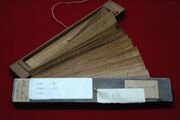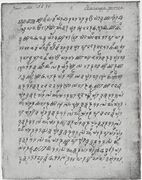الكتابة السوندائية
| Sundanese Script Aksara Sunda Baku ᮃᮊ᮪ᮞᮛ ᮞᮥᮔ᮪ᮓ | |
|---|---|
 | |
| النوع | |
| اللغات | السوندائية |
| الفترة الزمنية | ح. 14th–18th centuries (as Old Sundanese script) 1996-present (as Sundanese script) |
النظم الوالدة | |
النظم الشقيقة | Balinese Batak Baybayin scripts Javanese Lontara Lampung Makasar Rencong Rejang |
| الاتجاه | Left-to-right |
| ISO 15924 | Sund, 362 |
مرادف اليونيكود | Sundanese |
| |
| الكتابات البراهمية |
|---|
| الكتابة البراهمية وذريتها |
الكتابة السوندائية الفصحى (Aksara Sunda Baku، ᮃᮊ᮪ᮞᮛ ᮞᮥᮔ᮪ᮓ ᮘᮊᮥ ؛ Sundanese script) هي نظام كتابة يستخدمه شعب سوندا. It is built based on Old Sundanese script (Aksara Sunda Kuno) which was used by the ancient Sundanese from the 14th to the 18th centuries.[1]
التاريخ
Old Sundanese was developed based on the Pallava script of India,[2] and was used from the 14th until the 18th centuries. The last manuscript written in Old Sundanese script was Carita Waruga Guru.[2] From the 17th to the 19th centuries, Sundanese was mostly spoken and not written.[2] Javanese and Pegon scripts were used to write Sundanese during this period.[2] In 1996, the government of West Java announced a plan to introduce an official Sundanese script, and in October 1997, the Old Sundanese script was chosen and renamed to Aksara Sunda.[3]
الكتابة
The standardized script has 32 basic characters, consisting of 7 aksara swara (independent vowels): a, é, i, o, u, e, and eu, and 23 aksara ngalagéna (consonants with vowel a): ka-ga-nga, ca-ja-nya, ta-da-na, pa-ba-ma, ya-ra-la, wa-sa-ha, fa-va-qa-xa-za.
The additional five sounds to the ngalagena characters were added to fulfill the purpose of the Sundanese script as a tool for recording the development of the Sundanese language, especially by absorption of foreign words and sounds. However, the glyphs for the new characters are not new, but reuse several variants in the old Sundanese script, for example: the glyphs for fa and va are variants of Old Sundanese pa, the glyphs for qa and xa are variants of Old Sundanese ka, and the glyph for za is a variant of Old Sundanese ja.
There are two non-standard sounds, kha and sha, for writing foreign Arabic consonants ⟨خ⟩ and ⟨ش⟩. These are considered non-standard because their usage is only supported by a few Sundanese people.
There are also rarangkén or attachments for removing, modifying, or adding vowel or consonant sounds to the base characters. 13 rarangkén based on the position to the base can be categorized into three groups: (1) five rarangkén above the base characters, (2) three rarangkén below the base characters, and (3) five rarangkén inline the base characters. In addition, there are glyphs for number characters, from zero to nine.
Graphically, ngalagena characters including rarangkén have angles 45° – 75°. In general, the dimension ratio (height:width) is 4:4, except for the ngalagena character ra (4:3), ba and nya (4:6), and the swara character i (4:3). Rarangkén have a dimension ratio of 2:2, except for panyecek (1:1), panglayar (4:2), panyakra (2:4), pamaéh (4:2) and pamingkal (2:4 bottom-side, 3:2 right-side). Numbers have a ratio of 4:4, except for numbers 4 and 5 (4:3).
الصوائت المستقلة
| ᮃ = a /a/ | ᮆ = é /ɛ/ | ᮄ = i /i/ | ᮇ = o /ɔ/ |
| ᮅ = u /u/ | ᮈ = e /ə/ | ᮉ = eu /ɤ/ |
الصوامت
Consonants used for native phonemes
| ᮊ = ka /ka/ | ᮌ = ga /ga/ | ᮍ = nga /ŋa/ |
| ᮎ = ca /t͜ɕa/ | ᮏ = ja /d͜ʑa/ | ᮑ = nya /ɲa/ |
| ᮒ = ta /ta/ | ᮓ = da /da/ | ᮔ = na /na/ |
| ᮕ = pa /pa/ | ᮘ = ba /ba/ | ᮙ = ma /ma/ |
| ᮚ = ya /ja/ | ᮛ = ra /ra/ | ᮜ = la /la/ |
| ᮝ = wa /wa/ | ᮞ = sa /sa/ | ᮠ = ha /ha/ |
Consonants for writing foreign words
| ᮖ = fa /fa/ | ᮋ = qa /ka~qa/ | ᮗ = va /fa~va/ | ᮟ = xa /sa~ksa/ | ᮐ = za /za/ | ᮮ = kha /ha~xa/* | ᮯ = sya /ɕa~ʃa/* |
*The usage is not supported by some users.
التشكيل الصائت
Based on their location to the base glyph, 14 rarangkén can be categorized as:
- Rarangkén above the base glyph = 5 kinds
- Rarangkén below the base glyph = 3 kinds
- Rarangkén inline the base glyph = 5 kinds
a. Vowel diacritics above the base glyph
| ᮤ | Panghulu, modifies the vowel /a/ to /i/.
Example: ᮊᮤ (ki) |
| ᮨ | Pamepet, modifies the vowel /a/ to /ə/.
Example: ᮊᮨ (ke) |
| ᮩ | Paneuleung, modifies the vowel /a/ to /ɤ/.
Example: ᮊᮩ (keu) |
| ᮁ | Panglayar, adds a final /r/ to the base sound.
Example: ᮊᮁ (kar) |
| ᮀ | Panyecek, adds a final /ŋ/ to the base sound.
Example: ᮊᮀ (kang) |
b. Vowel diacritics below the base glyph
| ᮥ | Panyuku, modifies the vowel /a/ to /u/.
Example: ᮊᮥ (ku) |
| ᮢ | Panyakra, inserts the consonant /r/ to the base sound.
Example: ᮊᮢ (kra) |
| ᮣ | Panyiku, inserts the consonant /l/ to the base sound.
Example: ᮊᮣ (kla) |
c. Vowel diacritics inline the base glyph
| ᮦ | Panéléng, modifies vowel /a/ to /e/.
Example: ᮊᮦ (ké) |
| ᮧ | Panolong, modifies the vowel /a/ to /o/.
Example: ᮊᮧ (ko) |
| ᮡ | Pamingkal, inserts the consonant /j/ to the base sound.
Example: ᮊᮡ (kya) |
| ᮂ | Pangwisad, adds final consonant sound /h/ to the base sound.
Example: ᮊᮂ (kah) |
| ᮪ | Patén or pamaéh, removes vowel sound of the base sound.
Example: ᮊ᮪ (k) |
الأعداد
| الأعداد السوندائية | ᮰ | ᮱ | ᮲ | ᮳ | ᮴ | ᮵ | ᮶ | ᮷ | ᮸ | ᮹ |
|---|---|---|---|---|---|---|---|---|---|---|
| Hindu-Arabic numerals | 0 | 1 | 2 | 3 | 4 | 5 | 6 | 7 | 8 | 9 |
In texts, numbers are written surrounded with dual pipe sign | ... |.
Example: |᮲᮰᮲᮰| = 2020
علامات التنقيط
For modern use, Latin punctuations are used. Such punctuations are commas, dots, semicolons, colons, exclamation marks, question marks, quotes, parenthesis, brackets etc. Old Sundanese, though, was written using its own set of punctuation symbols. The bindu surya 〈᳀〉, the representation of the sun, is used in the sequence 〈᳆᳀᳆〉, which denoted a religious text. Likewise, the bindu panglong 〈᳁〉, the representation of a half moon, is used in the sequence 〈᳆᳁〉, which had the same meaning. A third punctuation sequence used as a liturgical text marker is 〈᳇᳇〉. The bindu purnama 〈᳂〉, on the other hand, representing a full moon, is used in the sequence 〈᳅᳂᳅〉, which denoted a historical text. Bindu surya is also sometimes used as the full stop; in this case, bindu purnama is also used as a comma. When bindu surya is not used as a full stop, bindu cakra 〈᳃〉, the representation of a wheel, was used instead of the bindu purnama as a comma.
The punctuation symbols resembling letters with stripes used in the sequences above, 〈᳆〉, 〈᳅〉, and 〈᳇〉, are respectively named da satanga, ka satanga, and ba satanga, and originated as "decorated" versions of the syllable da 〈ᮓ〉, one half of the syllable ka 〈ᮊ〉, and the syllable ba 〈ᮘ〉, respectively. To these can be added the leu satanga 〈᳄〉, of unclear meaning. Likewise, it originated as a "decorated" syllable leu 〈ᮼ〉, which is archaic.[4]
عناقيد الصوامت
Certain Sundanese words contain consonant clusters. Then, two ways of writing can be used: (1) using pamaéh, or (2) using pasangan (pairs).
The use of pamaéh is one way to write Sundanese script at the basic stage. Another way, the pasangan, is normally used to avoid the use of pamaéh in the middle of words, as well as to save writing space. Pasangan is constructed by attaching a second consonant letter to the first one, thus eliminating the /a/ vowel of the first consonant letter.
عينات
الفقرة 1 من الميثاق العالمي لحقوق الإنسان
ᮞᮊᮥᮙ᮪ᮔ ᮏᮜ᮪ᮙ ᮌᮥᮘᮢᮌ᮪ ᮊ ᮃᮜᮙ᮪ ᮓᮥᮑ ᮒᮦᮂ ᮞᮤᮕᮒ᮪ᮔ ᮙᮨᮁᮓᮤᮊ ᮏᮩᮀ ᮘᮧᮌ ᮙᮁᮒᮘᮒ᮪ ᮊᮒᮥᮒ᮪ ᮠᮊ᮪-ᮠᮊ᮪ ᮃᮔᮥ ᮞᮛᮥᮃ. ᮙᮛᮔᮦᮂᮔ ᮓᮤᮘᮦᮛᮦ ᮃᮊᮜ᮪ ᮏᮩᮀ ᮠᮒᮦ ᮔᮥᮛᮔᮤ, ᮎᮙ᮪ᮕᮥᮁ-ᮌᮅᮜ᮪ ᮏᮩᮀ ᮞᮞᮙᮔ ᮃᮚ ᮓᮤᮔ ᮞᮥᮙᮍᮨᮒ᮪ ᮓᮥᮓᮥᮜᮥᮛᮔ᮪.
Sakumna jalma gubrag ka alam dunya téh sipatna merdika jeung boga martabat katut hak-hak anu sarua. Maranéhna dibéré akal jeung haté nurani, campur-gaul jeung sasamana aya dina sumanget duduluran.
"All human beings are born free and equal in dignity and rights. They are endowed with reason and conscience and should act towards one another in a spirit of brotherhood."
يونيكود
Sundanese script was added to the Unicode Standard in April 2008 with the release of version 5.1. In version 6.3, the support of pasangan and some characters from Old Sundanese script were added.
الكتل
The Unicode block for Sundanese is U+1B80–U+1BBF. The Unicode block for Sundanese Supplement is U+1CC0–U+1CCF.
قالب:Unicode chart Sundanese قالب:Unicode chart Sundanese Supplement
معرض
A Sundanese lontar manuscript written in the Sundanese script.
انظر أيضاً
المراجع
- ^ Rosidi, Ajip (2010). Mengenang hidup orang lain: sejumlah obituari (in الإندونيسية). Kepustakaan Populer Gramedia. ISBN 9789799102225.
- ^ أ ب ت ث Ekadjati, Edi S. (September 2003). "Sundanese Manuscripts: Their Existence, Functions, and Contents" (PDF). Journal of the Centre for Documentation & Area-transcultural Studies. 2: 123–134.
- ^ "Sundanese". Atlas of Endangered Alphabets: Indigenous and minority writing systems, and the people who are trying to save them. (in الإنجليزية الأمريكية). Retrieved 2020-05-06.
- ^ EVERSON, Michael. Proposal for encoding additional Sundanese characters for Old Sundanese in the UCS. Available at [1]. September 5th, 2009.
وصلات خارجية
- CS1 الإندونيسية-language sources (id)
- CS1 الإنجليزية الأمريكية-language sources (en-us)
- Short description is different from Wikidata
- Scripts with ISO 15924 four-letter codes
- Articles containing Balinese-language text
- Articles with hatnote templates targeting a nonexistent page
- تقديمات القرن 14
- كتابات براهيمة
- كتابات إندونيسية
- ثقافة سوندا
- لغة سوندا
- الكتابة السوندائية



